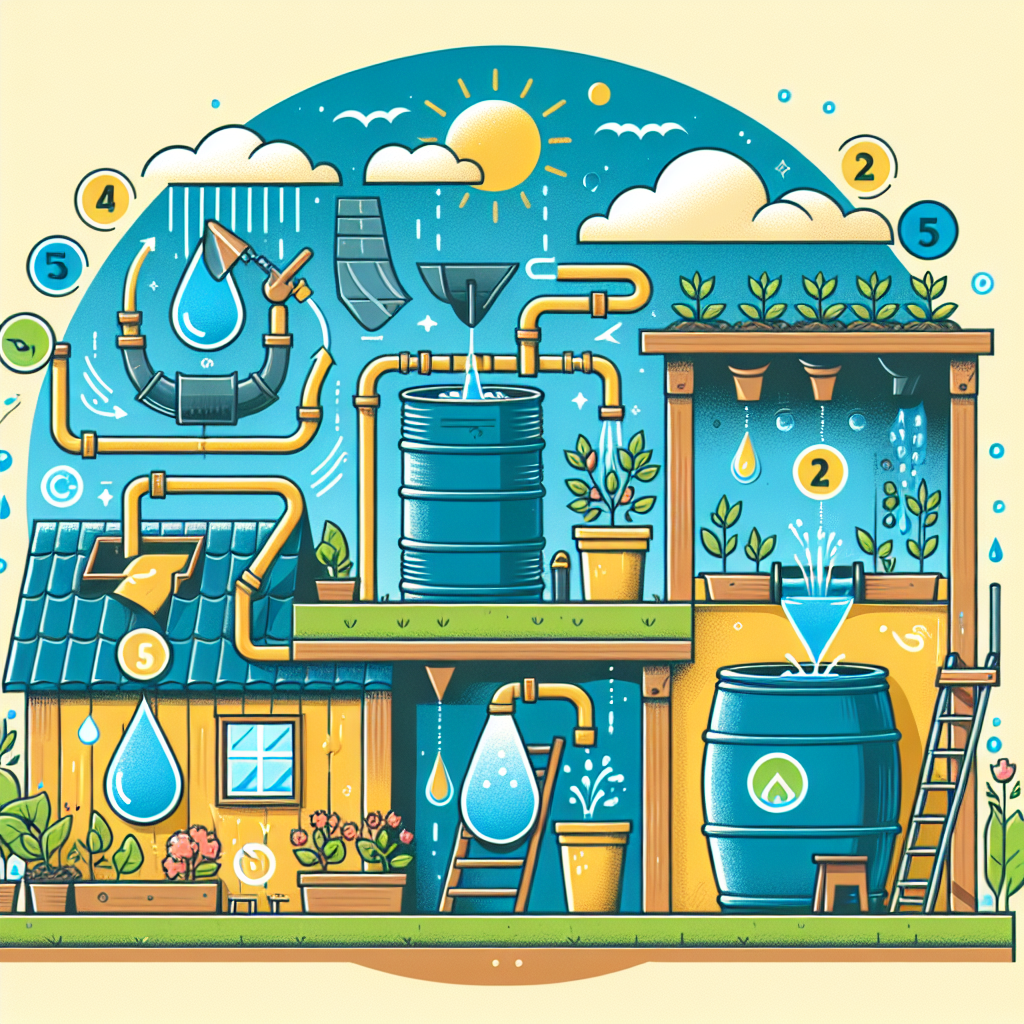DIY Rainwater Harvesting a Step-by-Step Guide for Beginners

Rainwater harvesting is a great way to save water and help the environment. By collecting and storing rainwater, you can use it for gardening, household chores, and even as an emergency water supply. This guide will walk you through the process of setting up your own DIY rainwater harvesting system, from planning to maintenance. It's a rewarding project that can save you money and make your home more sustainable.
Key Takeaways
- Rainwater harvesting is an effective way to conserve water and reduce your water bills.
- A DIY rainwater harvesting system can be customized to fit your specific needs and budget.
- Proper planning and choosing the right components are crucial for an efficient system.
- Regular maintenance is essential to keep your system running smoothly.
- Harvested rainwater can be used for various purposes, such as gardening, household chores, and emergencies.
Understanding Rainwater Harvesting DIY
What is Rainwater Harvesting?
Rainwater harvesting is the process of collecting and storing rainwater for later use. This ancient practice, dating back to the Romans and Mayans, involves capturing rainwater from surfaces like rooftops and directing it into storage containers. It's a simple yet effective way to conserve water. The collected rainwater can be used for various purposes, such as watering plants, flushing toilets, and even drinking if properly treated.
Why Choose a DIY Approach?
Opting for a DIY rainwater harvesting system allows you to customize it to your specific needs and budget. It's a rewarding project that not only saves money on water bills but also promotes environmental sustainability. Plus, setting up your own system can be a fun and educational experience for the whole family.
Benefits of Rainwater Harvesting
Rainwater harvesting offers numerous benefits, including:
- Cost Savings: Reduces your water bills by providing an alternative water source.
- Environmental Impact: Helps conserve natural water resources and reduces stormwater runoff.
- Self-Sufficiency: Provides a reliable water supply during droughts or water restrictions.
Embracing rainwater harvesting is a step towards a more sustainable and resilient future. It's a practical solution that anyone can implement, regardless of where they live.
Planning Your Rainwater Harvesting System
Before you start, it's important to know how much water you need. Calculate your daily water usage to figure out the size of the system you'll need. For instance, if your household uses 100 gallons of water per day, you'll need a system that can meet this demand. Knowing your water needs is the first step to an efficient system.
The collection surface is where the rainwater will be gathered. Most people use their roof, but you can also use other surfaces like patios or driveways. Make sure the surface is clean and free from contaminants. A clean collection surface ensures better water quality.
Designing the layout of your rainwater harvesting system involves planning where each component will go. Consider the placement of storage tanks, gutters, and downspouts. Ensure that the system is easily accessible for maintenance. Here's a simple checklist to help you design your layout:
- Identify the best location for your storage tank.
- Plan the route for gutters and downspouts.
- Ensure easy access for cleaning and maintenance.
- Include an overflow system to handle excess water.
Proper planning and design can save you a lot of headaches down the road. Take your time to get it right.
Essential Components for Your DIY Rainwater Harvesting System
Storage Tanks and Cisterns
Storage tanks are the heart of your rainwater harvesting system. They come in different sizes and materials like polyethylene, fiberglass, or concrete. The size you need depends on your roof area, average rainfall, and how you plan to use the water. Proper maintenance is key to keeping your water clean and safe.
Filtration and Purification Systems
Filtration systems are crucial for removing debris and contaminants from the collected rainwater. Common options include mesh screens, sediment filters, and UV purifiers. Choosing the right filtration system ensures your water stays clean and usable.
Conveyance Systems
Conveyance systems include gutters, downspouts, and pipes that direct rainwater from your roof to the storage tanks. A well-designed conveyance system prevents overflow and ensures efficient water collection. Regular checks and maintenance are essential to keep everything running smoothly.
Remember, each component plays a vital role in making your rainwater harvesting system effective and sustainable. Keep them well-maintained for the best results.
Step-by-Step Installation Guide
Installing your own rainwater harvesting system can be a fun and rewarding project. Follow these steps to set up your system efficiently and effectively.
Setting Up the Collection Surface
First, you need to prepare the area where you'll collect the rainwater. Most people use their roof, but you can also use other surfaces like patios or driveways. Make sure the surface is clean and free from contaminants. A clean collection surface ensures better water quality.
- Level the area next to your downspout. Clear away any rocks and debris.
- If the ground isn't flat, use a shovel to make it level.
- If your downspout empties onto a concrete driveway or patio, stack plywood boards to create a level surface.
Installing the Storage Tank
Next, you'll need to set up your storage tank. This is where the collected rainwater will be stored.
- Place the tank on a stable, level platform.
- Connect the downspout elbow to the downspout. This will direct water into the tank.
- Use a hacksaw to cut the downspout at the mark you made earlier.
- Fit the elbow to the downspout and fasten it with screws.
Connecting the Filtration System
Finally, it's time to connect the filtration system. This will ensure that the water you collect is clean and safe to use.
- Attach a mesh screen or sediment filter to the top of the tank to catch large debris.
- Install a first flush diverter to remove the initial flow of dirty water.
- Connect a UV purifier if you plan to use the water for drinking.
Proper planning and design can save you a lot of headaches down the road. Take your time to get it right.
Maintaining Your Rainwater Harvesting System
Regular System Checks
To keep your rainwater harvesting system running smoothly, it's important to perform regular checks. Inspect all parts of the system, including gutters, downspouts, and storage tanks, for any signs of wear or damage. Regular inspections help catch small issues before they become big problems.
Cleaning and Replacing Filters
Filters play a crucial role in keeping your harvested rainwater clean. Over time, they can get clogged with debris, reducing their effectiveness. Make it a habit to clean or replace filters regularly. This ensures that your water remains clean and safe for use.
Managing Overflow and Excess Water
During heavy rains, your system might collect more water than it can store. To handle this, install an overflow pipe that directs excess water to a safe area, like a garden or drainage system. This prevents flooding and keeps your system working efficiently.
Remember, a well-maintained system not only lasts longer but also provides cleaner water. Regular upkeep is key to enjoying the benefits of your rainwater harvesting system for years to come.
Maximizing the Use of Harvested Rainwater
Using Rainwater for Gardening
One of the best ways to use harvested rainwater is for gardening. Rainwater is free from chemicals found in tap water, making it perfect for plants. You can set up a simple gravity-fed irrigation system to distribute water efficiently. This not only saves money but also promotes healthier plant growth.
Household Uses for Rainwater
Harvested rainwater can be used for various household tasks. From flushing toilets to washing clothes, utilizing rainwater reduces your dependency on municipal water supplies. Installing a simple rain barrel system can be a cost-effective way to start. By connecting multiple barrels, you can easily increase your storage capacity.
Emergency Water Supply
In times of water shortages or emergencies, having a stored supply of rainwater can be a lifesaver. It provides a reliable backup when other sources are unavailable. Make sure to keep your storage tanks clean and well-maintained to ensure the water remains safe for use.
Remember, every drop counts. By maximizing the use of harvested rainwater, you're not only conserving a precious resource but also contributing to a more sustainable future.
Overcoming Common Challenges
Dealing with Local Regulations
Before you start your rainwater harvesting project, it's crucial to check local laws and regulations. Some areas have strict rules about collecting and using rainwater. Consulting with local authorities can help you understand any permits or restrictions you might face. This way, you can ensure your system is compliant and avoid any legal issues down the road.
Ensuring Water Quality
Maintaining high water quality is essential for safe use. Implementing proper filtration and purification systems is key. Regular maintenance, like cleaning gutters and checking filters, helps keep the water clean. By monitoring the water quality, you can address any issues promptly and ensure a sustainable water source.
Preventing System Overflows
During heavy rains, your system might overflow. To manage this, you can install an overflow pipe that directs excess water to a safe area, like a garden or a drainage system. This prevents flooding and ensures your rainwater harvesting system works efficiently.
Remember, overcoming these challenges is part of the journey to creating a sustainable and efficient rainwater harvesting system. With a bit of planning and regular maintenance, you can enjoy the benefits of harvested rainwater for years to come.
Conclusion
In conclusion, setting up your own DIY rainwater harvesting system is a fantastic way to save money and help the environment. It's a project that can be both fun and rewarding, giving you a sense of accomplishment as you watch your system collect and store rainwater. With just a bit of effort and some basic materials, you can reduce your water bills and make a positive impact on the planet. So, why not give it a try? Happy harvesting!
Frequently Asked Questions
What is rainwater harvesting?
Rainwater harvesting is the practice of collecting and storing rainwater for later use. It can be as simple as using barrels or as complex as systems with tanks and filters.
Why should I consider a DIY rainwater harvesting system?
A DIY rainwater harvesting system can help you save money on water bills, reduce your dependence on city water, and conserve an important natural resource.
What are the benefits of rainwater harvesting?
Rainwater harvesting helps save water, reduces runoff, and can lower your water bills. It also provides an alternative water source for gardening, household chores, and emergencies.
What components do I need for a rainwater harvesting system?
You will need a collection surface (like a roof), gutters, downspouts, a storage tank, and a filtration system to keep the water clean.
How do I maintain my rainwater harvesting system?
Regular maintenance includes checking the system, cleaning and replacing filters, and managing overflow to ensure everything works properly.
How do I manage overflow during heavy rains?
You can install an overflow pipe to direct excess water to a safe area, like a garden or drainage system. This helps prevent flooding and keeps your system efficient.

